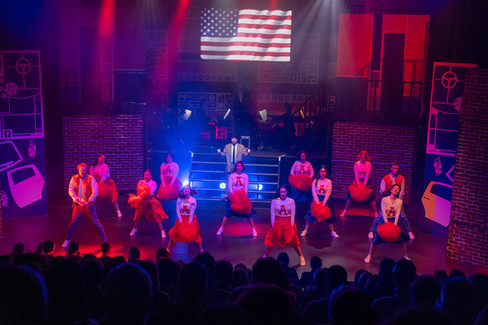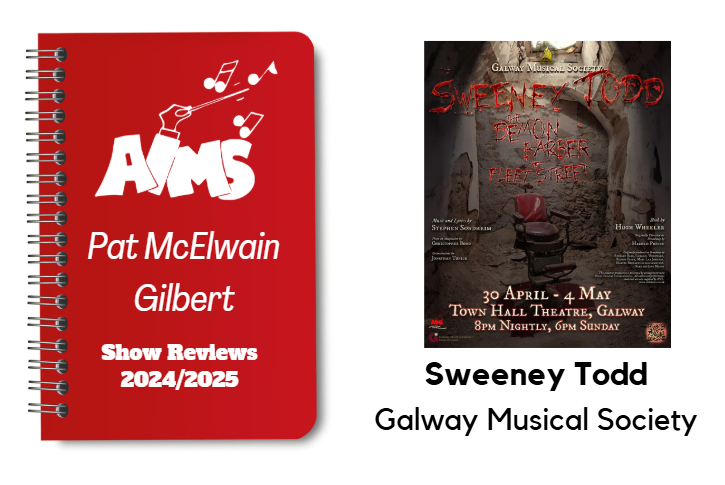Made in Dagenham as presented by Dun Laoghaire Musical & Dramatic Society
- Darragh Carroll

- Aug 6
- 7 min read

Society Name: Dun Laoghaire Musical & Dramatic Society
Show Name: Made in Dagenham
Adjudicator Date of Attendance: 09/04/2025
Brief Overview of Show and Evaluation of Front of House
Dun Laoghaire Musical & Dramatic Society’s production of Made in Dagenham was an exceptional and emotionally compelling staging of this powerful British musical. Drawing on the real-life events of the 1968 strike at the Ford Dagenham plant, the show blends humour, heart, and social commentary. This company rose admirably to the challenge of delivering a piece that requires both individual nuance and a strong collective identity.
From the outset, the atmosphere in the venue was upbeat and welcoming. Front of House staff were efficient and courteous, managing audience flow with clarity and professionalism. The energy in the auditorium before curtain-up was one of anticipation and support, and it was clear that the audience was eager to champion the performers.
Director – Direction and Production
Stephen Fagan’s direction was intelligent, detailed, and deeply respectful of the material. What stood out most clearly was the strength of the storytelling, from the larger arcs down to the smallest interactions. Every moment, scripted or not, was purposeful and character-driven, from background gestures to emotional crescendos. Each cast member was given space to create a believable, individual character, yet the group dynamic remained tight and unified. That balance is difficult to achieve, but this ensemble clearly trusted each other and their director. Stephen’s handling of dialect was also superb, the accent work was not only accurate but consistent, which added authenticity and depth to the production.
Visually, the use of levels on the set was strategic and effective, allowing for dynamic stage pictures and smooth transitions between scenes. The inclusion of real video footage from the 1960s was a masterstroke, connecting the fictionalised version to the factual roots of the story. This added emotional gravity, particularly in moments of confrontation or reflection.
Notably, the decision not to resolve Rita and Eddie’s conflict at the end was bold and gut-wrenching. It served as a poignant reminder of the cost of activism and the emotional toll of standing firm for one’s beliefs. This final note left a lasting impression, underscoring the weight of the story.
Musical Director – Direction and Orchestra
Barry Power led a tight and spirited orchestra that brought the score to life with vibrancy and style. The tempos throughout were perfectly judged, providing drive and urgency without rushing the singers. The band’s energy underpinned the show’s flow, giving it a constant forward motion.
Vocally, the cast was extremely well prepared. The harmonies were crisp, clear, and confidently delivered, with each line in the choral arrangements distinct yet balanced. The only critique lies in the sound mix, there were moments when the brass overpowered the keyboards, and some dialogue mid-song was difficult to hear. A bit more collaboration between MD and sound operator could enhance balance in future productions. Nevertheless, the musical direction brought out the full colour of David Arnold’s score, ensuring the emotional highs and lows were well supported.
Choreographer – Choreography
Lauren Dooley’s choreography was a triumph in tone and utility. Rather than imposing generic dance routines, the movement was deeply rooted in character and era. The choreography supported the show’s working-class aesthetic while adding texture and energy to the storytelling.
The use of changing formations and continuous motion kept the stage visually interesting without overwhelming the performers or straying from the narrative. Importantly, the movement never felt out of place, it retained a grounded, natural quality that suited the world of the piece.
Lauren made excellent use of the full cast, incorporating all ability levels while ensuring consistency. The dance numbers were expressive and never gratuitous, enhancing rather than distracting from the storytelling.
Leading Principles – Singing and Acting
Rita O’Grady – Meg Whyte: Meg delivered an outstanding performance, anchoring the production with sincerity, warmth, and inner strength. She captured the journey of an ordinary woman rising to an extraordinary challenge with emotional intelligence and vocal beauty. Her maternal side was evident from the start, and her chemistry with Eddie was believable and textured. The vocal work was consistently strong, and her performance never felt forced or theatrical, just honest and deeply human.
Eddie O’Grady – David Hynes: David brought charm and complexity to the role of Eddie. He convincingly embodied a working man trying to do his best while failing to see the bigger picture. His interactions with Rita were nuanced, and his vocal performance was smooth, well-placed, and emotionally connected. His accent work was spot-on, and he brought just enough vulnerability to balance Eddie’s more thoughtless moments.
Connie Riley – Joanne Keeling: Joanne’s portrayal of Connie was a highlight of the evening. Her off-script acting was profoundly moving, small details like her faltering gait and subtle coughing into a tissue spoke volumes. Her vocal delivery was rich and sensitive, perfectly aligning with Connie’s emotional arc. Joanne managed to portray both the steel and the fragility of her character with grace and subtlety.
Monty – Dale Ayers: Dale’s Monty was warm-hearted, slightly cheeky, and provided a lovely sense of continuity between the women and the factory. Vocally secure and emotionally open, he added gravitas to the production.
Clare – Máirín Hayes: Máirín was a comedic delight as Clare. Her comic timing was sharp, and her conviction in the role never wavered. She fully embraced the quirks of her character, delivering each moment with energy and confidence. A strong vocal performance and well-shaped physicality completed a thoroughly enjoyable portrayal.
Beryl – Hannah Sheehy: Hannah was a standout. Her Beryl was laugh-out-loud funny, with excellent comic delivery and superb physical choices. The throughline of liking a drink added flavour without ever becoming excessive, and her cursing was authentic and well-motivated. She also demonstrated a powerful vocal presence.
Cass – Kate Canavan: Kate brought heart to the ensemble as Cass, gently portraying the more passive, easily swayed member of the group. Her performance was understated and effective, complementing the bolder personalities around her.
Sandra Beaumont – Lyndsey McKiernan: Lyndsey offered a strong portrayal of Sandra, blending assertiveness and vulnerability with poise. Her movement was confident and natural, and her performance elicited real sympathy as someone caught in a difficult position.
Supporting Roles – Singing and Acting
Barbara Castle – Kate Canning: Kate was magnetic as Barbara Castle. Her accent was flawless, and her stage presence commanding. She skillfully walked the line between political authority and personal frustration. Vocally strong, her only minor challenge was transitioning smoothly between vocal registers, but this never detracted from an otherwise excellent performance.
Harold Wilson – John Paul Coakley: John Paul was hysterical as Harold Wilson. His portrayal captured the bumbling, out-of-touch nature of the character without straying into caricature. His song was a comedic highlight of the evening.
Mr. Tooley – John May: John played Tooley with relish, smug, arrogant, and entirely unlikeable. His accent was strong and sustained, though maintaining a stronger forward focus and eye line would have helped land some of the text. Nonetheless, he made a lasting impression.
Cortina Man / Chubby Chuff – Gavin Molony: Gavin displayed impressive range in these contrasting roles. As Cortina Man, he exuded charm and charisma with a velvety smooth voice, and as Chubby Chuff, he leaned into the awkward geeky humour with skill rather than placing it more towards the ignorant buffoon.
Mr. Hopkins - Kevin Johnston: Kevin gave a sharp, well-crafted performance as Mr. Hopkins. His accent was spot-on, and he perfectly captured the clueless arrogance of a self-serving British toff. His scenes with his wife were especially effective, adding depth and humour.
Lisa Hopkins – Hannah O’Dwyer: Hannah brought empathy and elegance to Lisa, navigating the emotional depth of a woman trapped in a patronising marriage. She gave a restrained yet deeply felt performance.
Gregory Hubble - Mikey Deasy, Ron Macer / Barry - Eoghan Funge, Sid - John Higgins, Ruairi Boland - Mr. Buckton: All delivered solid supporting work, fleshing out the world of the factory and its political landscape.
Sharon O’Grady - Bridget Cloonan, Graham O’Grady - Max Molins: Both were perfectly cast, endearingly annoying, just as they should be.
Chorus/Ensemble – Singing, Acting and Choreography
This ensemble was the beating heart of the production. Every member contributed meaningfully to the world of the show, with no weak links or passive presences. The character work extended beyond the leads, with each ensemble member creating a clear persona.
Vocally, they were powerful and unified. Harmonies were well-blended and tonally rich. Their energy never faltered, and their movement was sharp, expressive, and always in service of the story. Attention to formation spacing will be beneficial in future performances to ensure cleaner visual pictures.
Stage Management & Set Design
The set design was wonderfully evocative of the 1960s. The colour palette was carefully curated, and the use of upper levels and rolling trucks created a versatile space. The layered design allowed for fluid scene changes and a visually appealing backdrop.
The inclusion of video footage added powerful historical resonance. The cut-out cars, changing facades, and detailed set dressing enriched the world.
The flow of the show was maintained by the cast and costumes crew managing all of the transitions. Scene changes started strong but became slightly untidy toward the end. Continued rehearsal on these transitions would maintain the show’s slickness.
Technical – Lighting and Sound
Lighting design was tasteful and atmospheric. The use of specials created clear and dramatic visual moods. The FOH focus was clean with no dark patches or hotspots and evenly spread between US and DS. Slightly more front and backlighting on the cut-out back wall would have helped highlight this beautiful feature.
Sound was generally good, but dialogue during musical underscoring occasionally got lost. The keyboards were slightly light in the mix. A distracting phone sound effect in the hospital scene undercut the poignancy of the moment.
Visual – Costumes, Hair and Make-Up
Costumes were very era-appropriate and character-specific. The palette was cohesive and visually appealing. Hair and make-up were similarly well-matched to the period and characters. A small note: Mr. Hopkins’ jacket appeared ill-fitting, which seemed at odds with his character’s polished appearance. Cortina dancers might have benefitted from more stylised make-up to match their showy choreography.
Adjudicators suggestions/ comments- overall comments on the production and comments to enhance the standard for future performances.
This was a truly stirring and dynamic production of Made in Dagenham. The direction was thoughtful and bold, the cast performances were nuanced and compelling, and the technical and design aspects served the show with creativity and professionalism.
To further elevate future productions:
Continue refining sound balances between band and vocals.
Ensure scene transitions stay tight throughout.
Push ensemble formations for even cleaner visuals.
This production was a celebration of ensemble spirit, storytelling, and the power of amateur theatre.
Photos by Darragh Carroll






















Comments